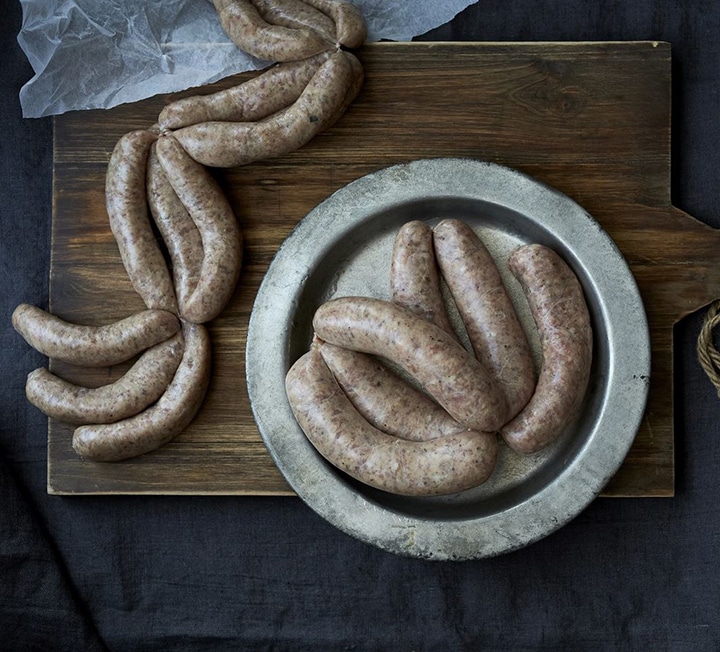Don’t follow the herd
Northfield Farm takes a singular approach to farming, blending centuries-old traditions with an openness to innovation. Clare Finney pays a visit to a family farm that’s been a vital part of the Borough Market community for more than two decades
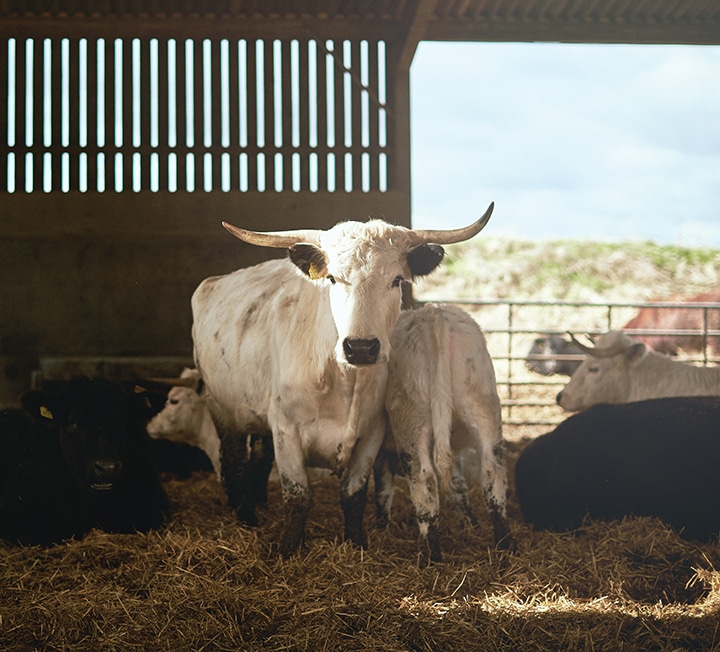

“JAN IS A BIG FAN OF NATURAL PEST CONTROL. HE’S A FAN OF NATURE GENERALLY. BUT NOT AT THE EXPENSE OF PROGRESS”
Images: Christopher L Proctor
“Being a farmer isn’t something you switch on when your alarm goes off, and turn off again come the evening,” says Leo McCourt. “You’re always a farmer.” His dad, Jan, nods in agreement. Jan has been breathing, eating and barely sleeping farming since he swapped banking for beef two decades ago, and while he has since handed over many of the operational responsibilities to Leo and Dom, his second son, he remains very much involved.
We’re at Northfield Farm now: ensconced in what seems the very essence of a farmhouse kitchen. Rustic wooden table? Check. Aga? Check. ‘Proper’ milk? Check. The only point of incongruity is the farm dog: half deaf, half blind and “very smelly,” says Jan fondly. “I rescued her 14 years ago.” His working dogs – two tall, gleaming New Zealand huntaways – are outside with the cats (also rescued) and the llamas, between them warding off rats, foxes and badgers.
Jan is a big fan of natural pest control. In fact, he’s a big fan of nature generally – it comes with the territory, as a farmer – but that doesn’t come at the expense of progress. When we arrive, Jan points out two windmills: one of them two centuries old and the other, built to power the local abattoir, modern and new. It seems not insignificant that they sit either side of Northfield Farm.
Jan smiles when I point this out. “We are in many ways on the cusp of history,” he says. On the one hand, the farm is a very traditional operation, home to some of the oldest rare breeds in the country. The white park, Jan’s “particular passion”, has been raised in Britain for 2,000 years, and is closely related to our native wild cattle.
Yet, in order to preserve the integrity of this breed and others, Jan has embraced the advances in technology bestowed by recent decades. He screens annually for common diseases, a practice that reduces vets bills and removes the need for antibiotics “almost entirely”. He also closely monitors the various characteristics of the herds, particularly the cattle. “We are always monitoring: ease of calving, fat cover, muscle size, fertility – even testicle circumference! – and we trace these back to individual genetics. It is a very scientific process,” Jan explains.
This isn’t high tech farming as we know it: intensive, mechanised industries designed to produce a lot of meat in very little time. This is “using science to be traditional.” Testing annually for disease means meat that’s free from antibiotics. Keeping abreast of genetic inheritance and applying that knowledge to breeding, meanwhile, helps Jan maintain the defining characteristics of rare breeds like the beef shorthorn and white park.
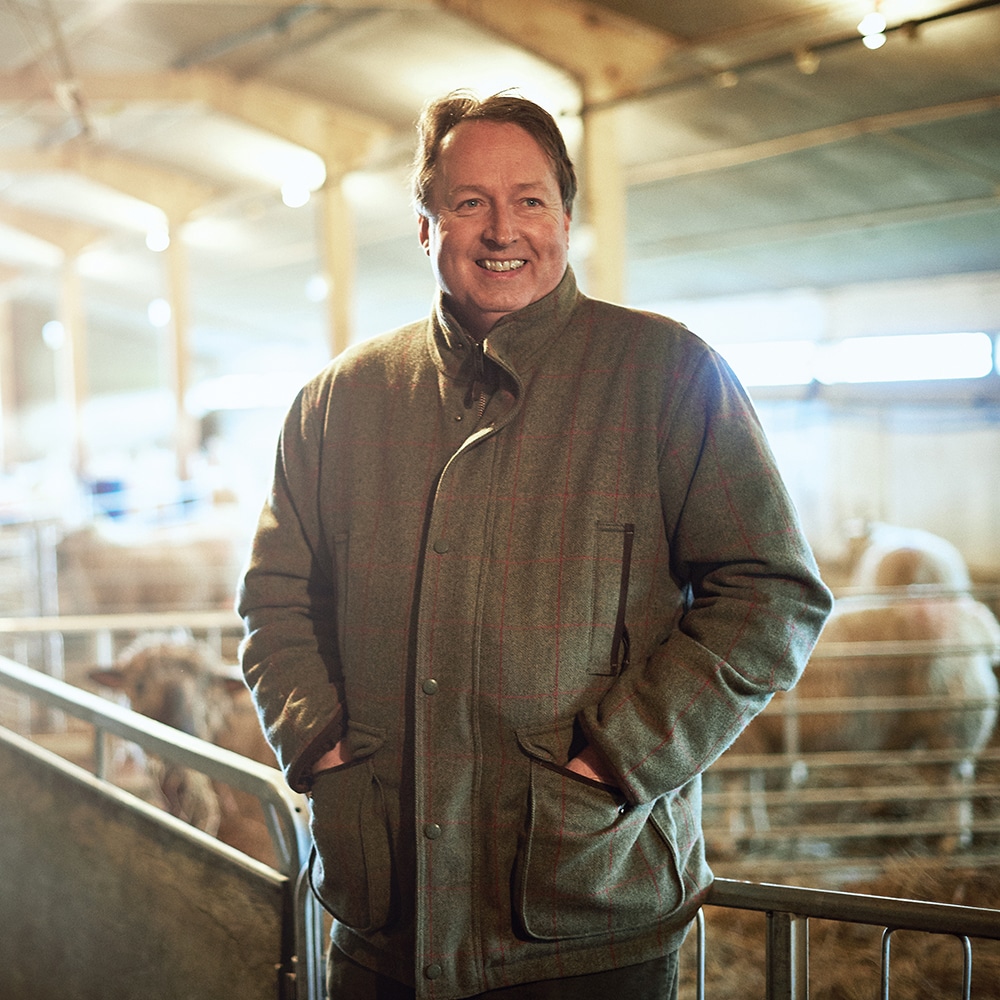
Being a small-scale producer isn’t easy. “You sit on a pile of debt for years and it doesn’t take much to set you off track,” Jan continues. Knowing which bulls to breed and which cows will calve without complications makes the farm more efficient, without compromising the values at its heart. All businesses need to be efficient, but efficiency does not have to come at a cost to society and the environment. Northfield strives for efficiency, but is also a model of good business practice, spanning environmental vigilance and social responsibility.
Upon arrival, the first thing we notice is the pile of silage bales, stacked high beside the tractor shed and wrapped in candyfloss-pink plastic. “They raise money for breast cancer,” Jan smiles. “I know they look a bit incongruous, but I like them. They’re recyclable and they don’t heat the silage up as much as the black ones, either.” Standing out vividly against the slate Rutland skies, they are a striking reminder that CSR isn’t just a feature of big City firms.
They host open farm days, welcoming children and adults alike into their butchery, onto their tractors and around their fields of sheep and cattle. They offer catering to local charity events, stock local produce in their farm shop and, most strikingly, having started working with neighbouring farmers in an informal cooperative, lending machines and even the odd pair of hands.
“Farming is highly capital intensive,” says Leo. “You can’t do anything for less than 20 grand and come silage time you need 10 or 15 machines just to do the work. We can do it much faster if there’s three or four of us together, with machines.” There’s no official arrangement, Leo continues. “It just came about over a curry one evening. We were chatting about what machines we had and what machines we would like to get, and suddenly the penny dropped that if we joined forces, we’d be far more efficient than on our own.”
Such fellowship is typical of Northfield Farm: a dyed-in-the-wool family business that agrees with Prince Charles’s maxim that “agriculture is made up of two words, and the ‘culture’ part of it is very important”. The age-old tradition of farming families, working together and helping each other out on the land, holds as much cultural and historical significance as those rare cattle breeds do. “Leo is part of a community up here, just as Dom is part of a community at Borough,” says Jan. Dom, the family ‘townie’ has been leading the butchery at Borough Market for some years now. “There is an interdependence of small farms up here, like there is interdependence of traders down at the Market,” says Jan.
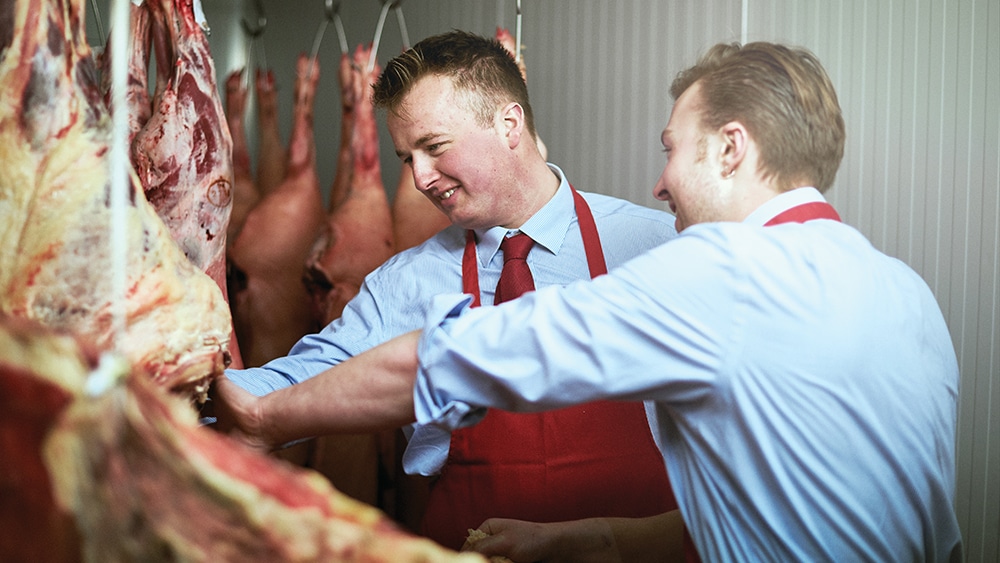
All of this seems intrinsically connected: the rugged Rutland landscape, the farming community, the rich food heritage of Melton Mowbray, and the breeds which for centuries have been feeding Britons and acclimatising to British terrain. Jan reaches up to the kitchen shelf and pulls down a large volume: musty, beautifully bound, full of hand-drawn diagrams. “This is the farmers’ bible: Stephens’ Book of the Farm, written in the 1800s,” he says excitedly. “This is where I first read about rare breeds.”
Back then, they “weren’t ‘rare’ breeds at all, but the breeds of the time,” he continues, leafing through the pages. Yet when Jan came to establish Northfield Farm in the late 1990s, “most farmers thought I was nuts, with my white parks and my little farm shop. They were all about animals they could intensively breed.”
A quarter of a century on, it seems Jan was a bellwether. “The number of people that are now feeling this desire to have contact with the land has increased significantly.” What’s more, with farmers’ markets, farm shops, holiday lets and butchery classes all on the table, the viability of small scale farming has also increased.
“Big farms concentrate on yields. We take much longer to finish the animals, so we have much higher costs,” says Jan. Beef cattle at Northfield Farm take nine months to be born, then just over three years to reach maturity, Jan continues. That’s over two years more than your average supermarket-bound specimen. “Then we hang the meat for 28 days to age it” – so that’s four years, and thousands of pounds’ worth of feed, space and labour, before making a penny. Diversification, for the McCourts, as for many of their small scale farming contemporaries, has offered some invaluable income streams.
So, is it worth it – the expense, time and space these great, ancient animals need, when there are such easy, cheap alternatives available? Beyond their almost biblical beauty (which, walking around the farm, is truly striking: sickle horns, jet black ears, and large dark eyes set in tufty coats of creamy ivory) and their historical importance, it is difficult to see why a farmer would go to such lengths. Then you taste the meat and it all falls into place. “They have this incredibly fine marbling, which when cooked is just stunning,” says Jan. Add the maturity, and the “grassy earthiness” that comes with a cow reared almost entirely on pasture, what you end up with is genuinely exceptional beef.
It’s not just white park, of course. Beef shorthorn, Aberdeen angus, angus-white park cross and flocks of sheep all graze on Northfield’s rich pasture. At the time of writing they are still wintering in airy barns, filled with Northfield hay and dining on Northfield silage – but the moment the grass starts growing again they’ll be let out to roam.
“We reconfigured our barns recently,” says Jan, recalling how a trip up to Scotland opened his eyes to how hardy native breeds of cattle are. “They thrived so much better in more basic conditions. We came back and changed the layout, so they wouldn’t overheat and would have more air. This crew yard is a very traditional way of wintering cattle.” Much as he welcomes the input of science, he continues, there is a lot to be said for “knowledge that has been acquired and passed down over a long time”. The trick is to combine the best of both scientific enquiry, and the wisdom years of experience brings.
The llamas are a case in point. Traditionally used in South America to ward off wolves, in the UK they’re increasingly being deployed to deter disease-carrying foxes and badgers. “I don’t want to tempt fate,” Dom ventures cautiously, “but since we have had these boys, we’ve not had a single case of TB.” Sentry-like, they prowl through the fields of the farm chasing “anything small and moving.” Before that, if the cattle were even suspected of having tuberculosis – even if their test proved inconclusive – they would have to be shot and disposed of.
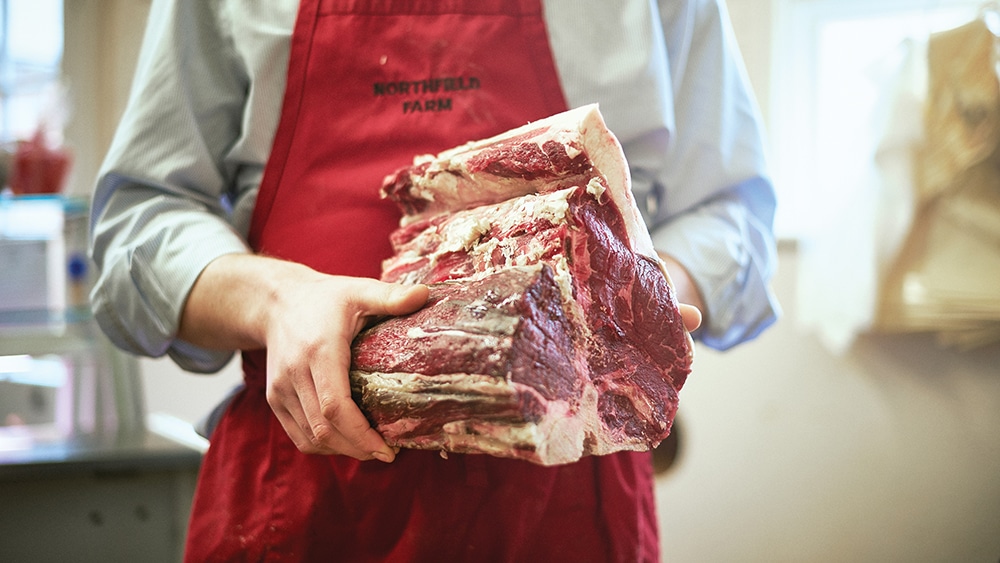
That would be a sorry end for any animal, but for one of such pedigree as these, to die in vain is heart-breaking. “These are family lines dating back hundreds of years. Some have been cows bearing calves,” Jan says sorrowfully. His philosophy is that “if you are going to kill an animal, you have a duty do the best you can by it – in life as well as in death.” It’s a philosophy that has informed his entire approach to livestock farming, from the genetic tests right through to his views on pasture feeding. If possible, tried and tested traditional practices should be adhered to, he says, but this should never be at the expense of the animal’s welfare, or the quality of the produce it creates.
“The term ‘pasture-fed’ is a contentious one,” explains Jan. “What the evangelism of the 100 per cent pasture-fed lobby don’t allow for is this duty you have toward the animal.” That includes how you finish it and the quality of the end product, Jan continues. “We do finish our beef on pasture and silage, but sometimes they need a little bit more.” He likens it to people occasionally needing to supplement their diets if they’re deficient in a particular nutrient, or have been ill: “It’s the equivalent of a few bowls of muesli. There’s nothing unnatural in it. We don’t add it if we don’t need to, but if we’re finishing a skinny animal, we’re producing meat that is no good to anyone.”
Like ‘efficiency’, the word ‘supplement’ can be a dirty one, conjuring up notions of refined sugars, antibiotics and other additives to cattle feed. “Much of the beef you buy in a supermarket will have been finished very quickly, on grain-based diets,” Jan points out, “but if we’re supplementing the food for our animals, it’s the tops of sugar beets combined with barley from the nearby mill.” It couldn’t be more natural, he continues.
As far as terroir goes, it’s all local produce; and as for speeding things up, the thought could not be further from the McCourts’ minds. “We’d finish our meat at six years if the economics of the market allowed us to. Six years would be perfect. It would be amazingly marbled and flavoursome – but we’d have to charge double what we do currently, which just isn’t feasible.” As ever, the gossamer balance between what is desirable and what is possible is never too far from Jan’s mind.
We head back toward the kitchen, via the curing room in which shoulders of pork sourced from their neighbouring pig farmers are being slowly cured into collar bacon. “We are one of the few places that produce collar bacon – an old fashioned, highly marbled cut off the shoulder,” Jan says proudly. Next door, the less sought-after cuts are being cooked up to make products that can be sold at the stall. “We have to use up the less valuable bits of the carcass. Only when you have shifted the last bit of lamb, pig or cattle are we starting to earn anything.” The aromas billow enticingly; rich meatiness, fragrant herbs, luscious grassiness – and our tummies start rumbling. In the kitchen, we wait to be served the edible proof of Jan’s farming philosophy. Sizzled to perfection, scattered with pomegranate seeds, and served with fresh orzo and sundried tomato salad, our lunch of roast lamb couldn’t have been more illustrative. There was tradition, in the form of the very old, very functional Aga; sparkling modernity in the form of on-trend pomegranate seeds; and collaborative spirit in the bronze-dyed orzo, sourced from an Italian family cooperative. There was the lamb: mature enough to boast the rich, verdant flavours of fresh grass, yet tender – a sign of high welfare and a talented butcher. To Northfield Farm, and to its principled blend of history and science, there could be no tastier testimony.

